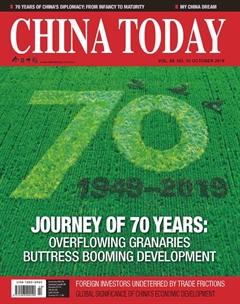70 Years: Growth and Contribution
This year marks the 70th anniversary of the founding of the Peoples Republic of China. Over the past seven decades, tremendous changes have taken place in the life of the Chinese people.
Where in the past people survived on a diet of coarse grains, modern China now has one of the widest ranges of nutritious foods in the world with everything including rice, noodles, vegetables, and meat being on the table. Rural China has seen the relocation and renovation of villagers and townspeople who have gradually moved into modern accommodation, and the construction of new villages has also significantly improved the living conditions of farmers. Transport has developed exponentially and now the once crowded and slow green-coated trains have been phased out, replaced by sleek, fast, and comfortable high-speed trains, making intercity commuting convenient. Culturally, public libraries, museums, radio, books, movies, and television have increasingly allowed Chinese people to expand their horizons and better understand their own country and the world they live in. Health has also become a priority for China. In the past, lack of medical care and medicines were a national challenge, which has been overcome by the overall coverage of health insurance. These changes contribute to the improvement of life expectancy in China, which has risen from 35 years when the PRC was founded, to 77 years currently.
Chinas rural areas have moved from widespread poverty to overall eradication of absolute poverty. China is the first developing country to achieve the UNs poverty reduction goal, contributing more than 70 percent to global poverty reduction.
The rapid development of science and technology has led to continuous achievements in scientific research in China. At the end of 2018, the number of invention patents per 10,000 people stood at 11.5. Major achievements have also been made in manned space flight, lunar exploration projects, quantum science, deep sea exploration, supercomputing, satellite navigation and many other fields, and the results of innovationdriven development strategy are impressive. High technology is the engine of future development. With the improvement of scientific and technological strength, China has gradually become an active contributor to international scientific and technological infrastructure and an active participant and leading organizer of major international scientific programs and projects. China has actively participated in major international scientific programs and projects such as the Human Genome Project, the International Thermonuclear Fusion Experimental Reactor Project, and the Square Kilometer Array Radio Telescope.
Through scientific and technological cooperation, China has added momentum to the world economy by means of new scientific and technological growth points. China has not only attracted Tesla, Apple, Microsoft, Mercedes and other international technology giants to invest in the country, but also brought high-speed rail, nuclear power, port machinery and other hi-tech equipment to the international market. “Made in China,” Chinese equipment, “built in China,” and Chinese technology have landed in various countries to promote the common development of the world.
Over the past 70 years, China has not only strengthened itself but also become an important link in the global economic chain through accelerated infrastructure construction, steady development of basic industries, coordinated development of regional economies, and technological innovation. Chinese individuals, families and enterprises have all integrated into the tide of economic globalization.
As China furthers its opening-up, the consumer market with a population of 1.4 billion has become Chinas biggest dividend to the world. In the shopping carts of Chinese housewives, there are delicacies from all continents, and Chinese tourists and shoppers can be seen all over the world.
The proportion of Chinas mainland GDP in the worlds GDP rose from 1.8 percent at the beginning of reform and opening-up in 1978 to 15.2 percent in 2018. Since 2016, China has contributed more than 30 percent to the worlds economic growth. With its opening-up and development in recent years, China has become the worlds second largest economy, the largest manufacturing country, the largest trading country in goods, the second largest consumer of goods, and the second largest power in terms of inflow of foreign capital, with the largest foreign exchange reserves in the world for many consecutive years.
As Rebecca Fannin, an expert on global innovation, said in a post on the website of biweekly Forbes on September 8, an era of all-round innovation in China is unfolding.
Thanks to the rapid development of globalization, China will contribute to global innovation-driven initiatives, actively cooperate with other countries, and cultivate common new forces for human development.

